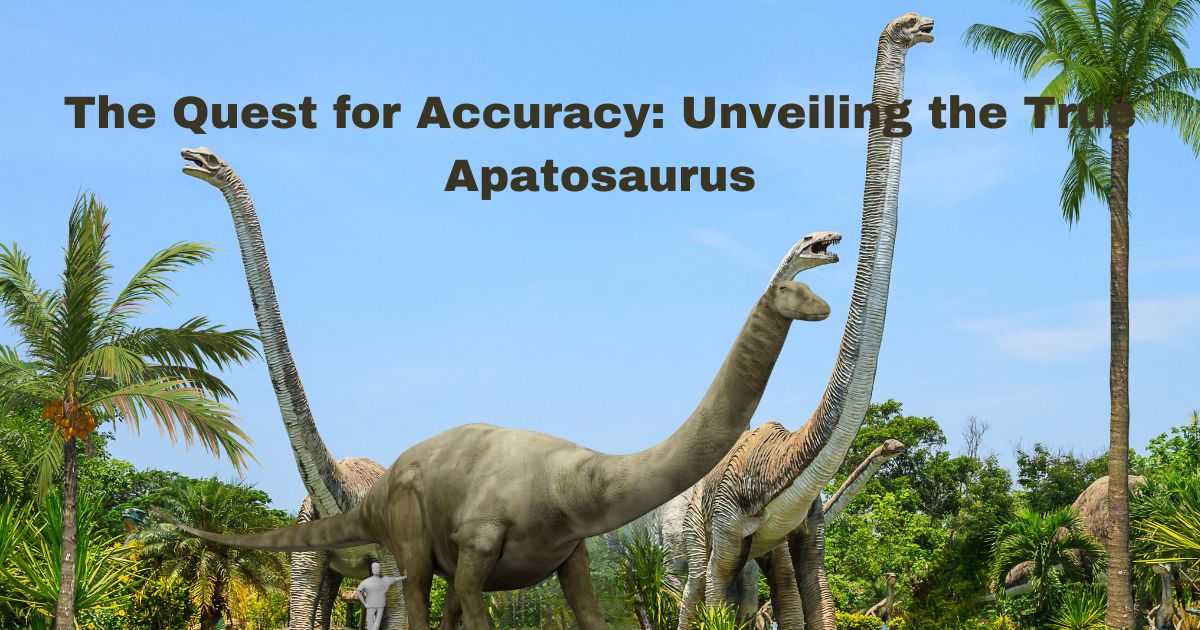The Quest for Accuracy: Unveiling the True Apatosaurus

Introduction
In the field of paleontology, accuracy is paramount. Solving the riddles of ancient animals depends on exact reproduction. One such surprising mammoth from the past is Apatosaurus. Let’s embark on a journey to the accuracy that surrounds this majestic dinosaur.
Exact Apatosaurus Unveiled
Clearing misconceptions
Apatosaurus, commonly known as the “beguiling reptile”, is regularly misunderstood. Numerous entertainments have featured her with mainstream highlights, leading to misinterpretations of her appearance and lifestyle.
Logical reappraisal
Recent logical evaluations have shed light on the true nature of Apatosaurus. Through rapid testing of fossil provenance and innovation, analysts have created a more accurate picture of this ancient behemoth.
Adjusting for past mistakes
Previous recreations have shown Apatosaurus with an incorrect cranium shape and pose. Be that as it may, advanced research has corrected these errors, providing a clearer picture of the structure and biomechanics of life
Unveiling the facts
Structures and physical characteristics of life
Accurate recreations show that Apatosaurus boasted a long neck, a powerful body, and a whip-like tail. Its obvious features, bare bones and spoon-shaped tooth count, show an adjustment to a vegetarian diet.
Estimation and measurement
Apatosaurus roamed the soil during the late Jurassic period, about 150 million years ago. It was one of the largest creatures to have ever lived, measuring up to 75 feet in length and weighing up to 25 tons.
Territory and behavior
Paleontologists accept that Apatosaurus lived in semi-arid conditions, where it likely foraged for vegetation in groups. His huge move can act as a deterrent against predators, despite the fact that Joe proves to be too locked into mob attitudes for the protection involved.
Challenges in Reconstruction
Fragmentary fossils
Despite advances in paleontological methods, reconstructing Apatosaurus still faces challenges due to fragmentary fossil evidence. Analysts must rely on comparative living systems and biomechanical modeling to accurately fill in the gaps.
Interpretive limitations
Interpretation of the behavior and physiology of extinct animals such as Apatosaurus remains somewhat theoretical. While advances in innovation provide important pieces of knowledge, there are inevitable limitations to fully understanding the complexities of ancient life.
Importance of accuracy
Logical significance
Accurate recreations of Apatosaurus are important for advancing our understanding of ancient biological systems and evolutionary history. By convincing these animals to be as convincing as possible, researchers can piece together the complex entanglements of Earth’s ancient past.
Pedagogical value
Inaccurate depictions of Apatosaurus can propagate misinterpretations and hinder teaching efforts. By displaying the most up-to-date and accurate data, teachers can stimulate interest and develop a deeper appreciation for biologists and science.
What is a Long-Necked Dinosaur Called? Red More…
FAQs For The Quest for Accuracy: Unveiling the True Apatosaurus
Q: How do researchers judge the accuracy of Apatosaurus reconstructions?
Researchers use a combination of fossil evidence, comparative life structures, biomechanical modeling, and advanced imaging techniques to accurately reconstruct Apatosaurus.
Q: What did Apatosaurus eat?
Apatosaurus was herbivorous, feeding on plants such as vegetables, cycads, and conifers.
Q: Was Apatosaurus the same creature?
Although single individuals may have existed, support the proposition that Apatosaurus likely lived in crowds to insure against predators.
Result
In the interest of unraveling the mysteries of ancient life, accuracy is paramount. Through logical investigation and modern developments, analysts continue to improve our understanding of animals like Apatosaurus. By visualizing these ancient monsters so vividly, we honor their legacy and expand our knowledge of Earth’s extraordinary history.